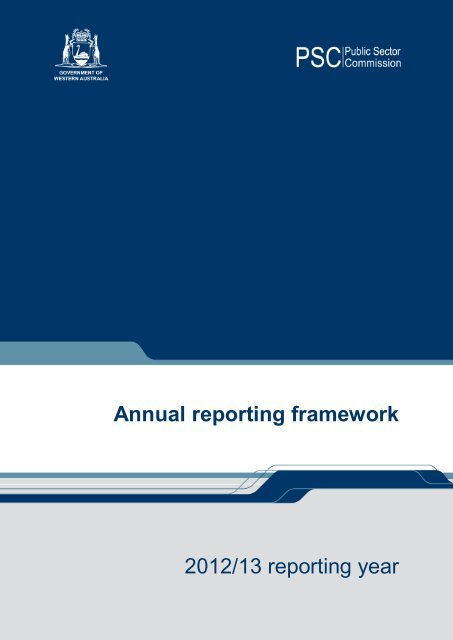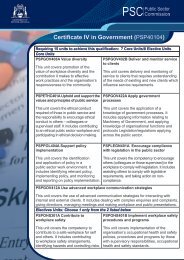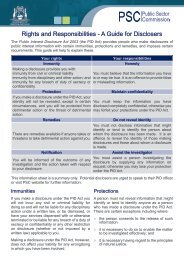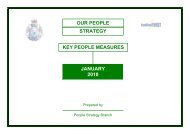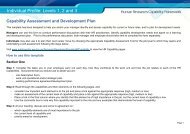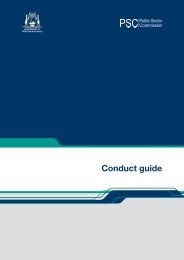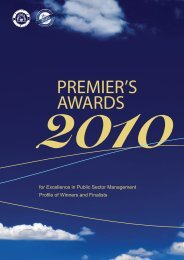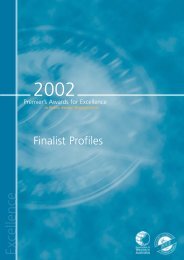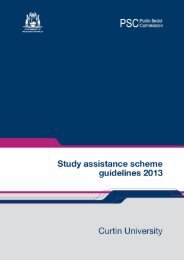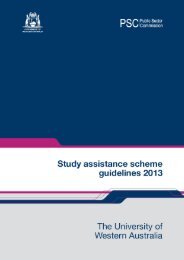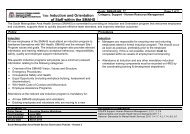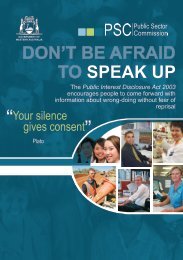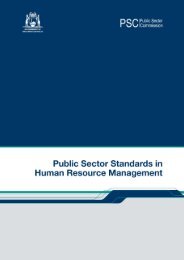Annual reporting framework 2012/13 reporting year - Public Sector ...
Annual reporting framework 2012/13 reporting year - Public Sector ...
Annual reporting framework 2012/13 reporting year - Public Sector ...
You also want an ePaper? Increase the reach of your titles
YUMPU automatically turns print PDFs into web optimized ePapers that Google loves.
<strong>Annual</strong> <strong>reporting</strong> <strong>framework</strong><br />
<strong>2012</strong>/<strong>13</strong> <strong>reporting</strong> <strong>year</strong>
Enquiries:<br />
Agency Support Division, <strong>Public</strong> <strong>Sector</strong> Commission<br />
Dumas House, 2 Havelock Street, West Perth 6005<br />
Locked Bag 3002, West Perth WA 6872<br />
Telephone: (08) 6552 8500 Fax: (08) 6552 8710<br />
Email: agencysupport@psc.wa.gov.au<br />
Website: www.publicsector.wa.gov.au<br />
© State of Western Australia <strong>2012</strong><br />
There is no objection to this publication being copied in whole or part, provided there is due<br />
acknowledgement of any material quoted or reproduced from the publication. Published by the <strong>Public</strong><br />
<strong>Sector</strong> Commission (Western Australia), March 20<strong>13</strong>. Copies of this report are available on the <strong>Public</strong><br />
<strong>Sector</strong> Commission website at www.publicsector.wa.gov.au.<br />
Disclaimer<br />
The Western Australian Government is committed to quality service to its customers and makes every<br />
attempt to ensure accuracy, currency and reliability of the data contained in these documents. However,<br />
changes in circumstances after time of publication may impact the quality of this information.<br />
Confirmation of the information may be sought from originating bodies or departments providing the<br />
information.<br />
Accessibility<br />
Copies of this document are available in alternative formats upon request.<br />
<strong>Annual</strong> <strong>reporting</strong> <strong>framework</strong> Error! Use the Home tab to apply Section Heading to the text that<br />
you want to appear here. 2
Contents<br />
Commissioner’s overview ......................................................................................... 4<br />
Introduction ............................................................................................................... 5<br />
1. Principles for <strong>reporting</strong>....................................................................................... 6<br />
Quality of information .................................................................................... 6<br />
Presentation .................................................................................................. 6<br />
Readability..................................................................................................... 7<br />
Format and layout ......................................................................................... 7<br />
2. Guidelines for <strong>reporting</strong> ..................................................................................... 8<br />
Timing ............................................................................................................ 8<br />
Distribution .................................................................................................... 8<br />
<strong>Public</strong>ation ................................................................................................... 10<br />
Feedback ..................................................................................................... <strong>13</strong><br />
<strong>Annual</strong> <strong>reporting</strong> awards ............................................................................. <strong>13</strong><br />
3. Sources of annual <strong>reporting</strong> requirements...................................................... 14<br />
Financial Management Act 2006 and Treasurer’s Instructions ................. 14<br />
Model annual reports .................................................................................. 14<br />
Other sources .............................................................................................. 15<br />
Government goals ....................................................................................... 15<br />
4. Structure and content of annual reports ......................................................... 16<br />
Overview of the agency .............................................................................. 16<br />
Agency performance ................................................................................... 17<br />
Significant issues impacting the agency .................................................... 17<br />
Disclosures and legal compliance .............................................................. 17<br />
Need assistance ................................................................................................... 24<br />
Department of Treasury .............................................................................. 24<br />
Department of the Premier and Cabinet .................................................... 24<br />
<strong>Public</strong> <strong>Sector</strong> Commission .......................................................................... 24<br />
Appendix A - annual report checklist ..................................................................... 25<br />
<strong>Annual</strong> <strong>reporting</strong> <strong>framework</strong> <strong>2012</strong>/<strong>13</strong> <strong>reporting</strong> <strong>year</strong> 3
Commissioner’s overview<br />
<strong>Annual</strong> reports are an important tool in assisting the public’s understanding of the<br />
operations of government agencies, as well as ensuring financial and performance<br />
accountability to the Western Australian Parliament. The <strong>Annual</strong> <strong>reporting</strong> <strong>framework</strong><br />
(the <strong>framework</strong>) is a guide to ensure that the various <strong>reporting</strong> obligations on agencies<br />
that are required under a range of different pieces of legislation can be readily identified<br />
and addressed consistently.<br />
The Commission facilitates the annual coordination and publication of the Framework,<br />
but content is provided by the Department of Treasury, Department of Finance,<br />
Department of Premier and Cabinet, Department of Commerce, WA Electoral<br />
Commission, Disabilities Service Commission, Equal Opportunity Commission, the State<br />
Library of WA and the National Library of Australia.<br />
The W.S Lonnie Awards, held annually by the Institute of <strong>Public</strong> Administration Australia<br />
WA, recognises the importance of annual reports being accountable and transparent and<br />
celebrates excellence in annual report writing. All public sector agencies in WA are<br />
considered as part of the judging process.<br />
I acknowledge the improvements made over the <strong>year</strong>s of agencies annual reports and<br />
also the improvement of the <strong>framework</strong> itself. By providing clear and consistent annual<br />
reports agencies act with integrity and in turn increase the reputation of the public sector.<br />
M C Wauchope<br />
PUBLIC SECTOR COMMISSIONER<br />
<strong>Annual</strong> Reporting Framework<br />
<strong>Annual</strong> <strong>reporting</strong> <strong>framework</strong> <strong>2012</strong>/<strong>13</strong> <strong>reporting</strong> <strong>year</strong> 4
Introduction<br />
This <strong>framework</strong> assists agencies in the preparation of annual reports by providing a<br />
summary of expectations and various <strong>reporting</strong> requirements.<br />
It is a requirement under s61 of the Financial Management Act 2006 (FMA) that the<br />
accountable authority of an agency prepares an annual report at the end of each<br />
financial <strong>year</strong>. An agency is defined as a department, sub-department or a statutory<br />
authority that is listed in Schedule 1.<br />
Agencies should also be familiar with legislation and policies that stipulate their annual<br />
<strong>reporting</strong> obligations, including:<br />
• <strong>Public</strong> <strong>Sector</strong> Management Act 1994 (s31) (PSMA)<br />
• Financial Management Act 2006 (FMA)<br />
• Treasurer’s instructions (TIs)<br />
• specific legislation including enabling legislation for statutory authorities<br />
• cabinet decisions<br />
• policy statements such as Premier’s Circulars, <strong>Public</strong> <strong>Sector</strong> Commissioner’s<br />
Circulars and <strong>Public</strong> <strong>Sector</strong> Commissioner’s Instructions<br />
• <strong>Public</strong> <strong>Sector</strong> Commissioner’s Circular 20<strong>13</strong>-01, <strong>Annual</strong> Reporting.<br />
Other agencies that are not subject to the FMA but are required to prepare an annual<br />
report should do so in accordance with their enabling legislation and consider how that<br />
legislation relates to the PSMA and FMA in terms of <strong>reporting</strong> requirements.<br />
The four sections that form the structure of the <strong>framework</strong> are:<br />
1. provides principles for the presentation and content of annual reports<br />
2. provides guidelines for timing, distribution and publication<br />
3. identifies the sources for annual <strong>reporting</strong> requirements<br />
4. outlines the structure and presentation of content.<br />
<strong>Annual</strong> <strong>reporting</strong> <strong>framework</strong> <strong>2012</strong>/<strong>13</strong> <strong>reporting</strong> <strong>year</strong> 5
1. Principles for <strong>reporting</strong><br />
The four principles agencies should follow for annual <strong>reporting</strong> are:<br />
• quality of information<br />
• presentation<br />
• readability<br />
• format and layout.<br />
Quality of information<br />
The quality of information contained in annual reports is paramount and should enable<br />
the reader to understand the agency, its purpose, services and performance.<br />
The annual report should be the primary mechanism for <strong>reporting</strong> agency performance<br />
against the strategic plan, budget papers, resource agreement and other strategic<br />
documents. It should also outline the agency’s contribution to broader Governmentdesired<br />
outcomes.<br />
Information should be factual, avoid generalisations and include all relevant information -<br />
not just ‘good news’. Outcomes should be emphasised, rather than process or<br />
procedure.<br />
All obligatory components of the annual report (listed in Sections 3 and 4 of this<br />
document) must be included. If the agency has no applicable information for a particular<br />
requirement, an appropriate explanation should be provided.<br />
The annual report should also specify the extent of the agency’s compliance with various<br />
legislative and Government policy requirements, as discussed in Section 4.<br />
Presentation<br />
With Parliament as the primary audience, annual reports should be presented as an<br />
objective account of agency performance, rather than be designed for promotion,<br />
marketing or other commercial purposes.<br />
While presentation can attract the reader and clarify content, agencies should keep costs<br />
as low as possible for graphics, photographs, artwork and printing.<br />
<strong>Annual</strong> <strong>reporting</strong> <strong>framework</strong> <strong>2012</strong>/<strong>13</strong> <strong>reporting</strong> <strong>year</strong> 6
Limited use of colour is permitted. Its purpose should be to add value to the report and<br />
enhance its readability. It should not be used extensively throughout the report or as a<br />
means of marketing or promoting the agency.<br />
If a glossy or colourful document is required, the agency should produce a document<br />
separate to the annual report, in accordance with the agency’s policy for developing<br />
promotional materials. Content extracted from the annual report may be used for such a<br />
document, but it should not be the official annual report.<br />
Readability<br />
Reports should be:<br />
• clear and concise – written in plain English, excluding unnecessary text and with<br />
minimal technical jargon.<br />
• easy to understand – key points of interest should be highlighted for readers, with<br />
graphs and comparative data to allow quick understanding of the report’s content.<br />
• written with the target audience in mind – the primary audience is<br />
parliamentarians, but agencies should consider a wide range of stakeholders,<br />
including special interest citizens’ groups, non-government organisations and the<br />
general public including people with disabilities. The language used should cater for<br />
all readers. For example, key financial information should be presented in plain<br />
language. Information should also be made available in alternative formats upon<br />
request.<br />
Format and layout<br />
The presentation of the annual report should be simple and logical, allowing readers to<br />
easily access information.<br />
A table of contents should be included that applies the recommended structure to<br />
present information as required in Section 4 of this document:<br />
• Overview of the agency.<br />
• Agency performance.<br />
• Significant issues impacting the agency.<br />
• Disclosures and legal compliance.<br />
<strong>Annual</strong> <strong>reporting</strong> <strong>framework</strong> <strong>2012</strong>/<strong>13</strong> <strong>reporting</strong> <strong>year</strong> 7
2. Guidelines for <strong>reporting</strong><br />
Agencies should consider specific guidelines for:<br />
• timing<br />
• distribution<br />
• publication, including accessibility considerations and <strong>reporting</strong> of costs<br />
• feedback<br />
• awards for public sector annual <strong>reporting</strong>.<br />
Timing<br />
Ministers must table audited annual reports, including the audit opinion on the financial<br />
statements and key performance indicators, in Parliament within 90 days of the end of<br />
the financial <strong>year</strong> (s64(2) FMA). Unless an Act provides otherwise, the financial <strong>year</strong> of<br />
an agency ends on 30 June. Taking into account Parliamentary Sitting Dates, this<br />
determines the deadline for <strong>2012</strong>/<strong>13</strong> <strong>reporting</strong> as Friday 27 September 20<strong>13</strong>*.<br />
Agencies should liaise with the Minister’s Office to ensure that the Minister is afforded<br />
sufficient time to consider the information and meet the tabling deadline. In the event that<br />
an annual report will not be tabled on time, the Minister must report to Parliament with<br />
reasons for the deadline not being met and advise of a revised date for tabling (s65<br />
FMA).<br />
*Agencies should refer to the enabling legislation for their entity as this may specify a different<br />
period or way of determining the date for submission.<br />
Contact: See Department of Treasury contacts on page 24.<br />
Distribution<br />
General<br />
Only a small number of hard copy annual reports should be produced as the main means<br />
of distribution and communication is the agency’s website.<br />
<strong>Annual</strong> <strong>reporting</strong> <strong>framework</strong> <strong>2012</strong>/<strong>13</strong> <strong>reporting</strong> <strong>year</strong> 8
Parliament<br />
Hard copies<br />
The agency must forward to the relevant Minister’s Office a total of eleven hard copies<br />
(and one electronic copy, discussed below) of the annual report to be tabled in<br />
Parliament unless the Minister’s Office requests additional copies.<br />
It is the responsibility of the Minister’s Office to forward ten hard copies and the<br />
electronic copy to the Parliamentary Services Branch, Department of the Premier and<br />
Cabinet (DPC), to facilitate tabling. The reports should be forwarded to:<br />
Peter Kennon<br />
Parliamentary Services Branch<br />
Department of the Premier and Cabinet<br />
1 Parliament Place<br />
WEST PERTH WA 6005<br />
Email: peter.kennon@dpc.wa.gov.au<br />
Electronic copies<br />
While it is the responsibility of the Minister’s Office to provide an electronic copy to the<br />
Parliamentary Services Branch, agencies may choose to submit the electronic copy<br />
directly by email or CD ROM. Note: large files should not be sent by email.<br />
Parliamentary Services will arrange the inclusion of an electronic copy of the agency’s<br />
annual report in Parliament’s Tabled Papers database, available at<br />
www.parliament.wa.gov.au<br />
Contact: Peter Kennon, Parliamentary Services, DPC, on 6552 5897 or<br />
peter.kennon@dpc.wa.gov.au<br />
Electronic copies should be generated at the source in Adobe Acrobat PDF format. The<br />
annual report should be contained in a single PDF file, which should not exceed 4MB in<br />
size, with relevant sections bookmarked to enable navigation from the table of contents.<br />
Images should be compressed at a low resolution to minimise the file size for download<br />
from the tabled papers database. The electronic file name should clearly indicate the<br />
agency name and <strong>reporting</strong> <strong>year</strong>, for example: ‘PSC AR 20<strong>13</strong>’ or ‘Fisheries AR 20<strong>13</strong>’.<br />
Contact: John Strijk, State Law Publisher, on 6552 6001 or john.strijk@dpc.wa.gov.au<br />
Libraries<br />
In addition to the above, the agency must deposit one hard copy with the National Library<br />
of Australia within one month of publication, see www.nla.gov.au/legal-deposit<br />
<strong>Annual</strong> <strong>reporting</strong> <strong>framework</strong> <strong>2012</strong>/<strong>13</strong> <strong>reporting</strong> <strong>year</strong> 9
One hard copy and one electronic copy in PDF format 1 must be deposited with the State<br />
Library of Western Australia, see Premier’s Circular 2003/17 - Requirements for Western<br />
Australian Government <strong>Public</strong>ations and Library Collections.<br />
Legal Deposit Unit<br />
National Library of Australia<br />
CANBERRA ACT 2600<br />
Phone: (02) 6262 <strong>13</strong>12<br />
Email: legaldep@nla.gov.au<br />
Serials<br />
State Library of Western Australia<br />
25 Francis Street<br />
PERTH WA 6000<br />
Phone: 9427 3348<br />
Email: serials@slwa.wa.gov.au<br />
The Minister’s Office must forward one hard copy to the DPC Library:<br />
Information Services<br />
Department of the Premier and Cabinet<br />
6 th Floor, 2 Havelock Street<br />
WEST PERTH 6005<br />
Phone: 6552 5888<br />
Email: dpclibrary@dpc.wa.gov.au<br />
<strong>Public</strong>ation<br />
Official version<br />
There must be only one official version of an agency’s annual report, which is the version<br />
tabled in Parliament. The content of subsequent copies of the report, including electronic<br />
versions, must be identical to the original report tabled in Parliament and include the<br />
information audited by the Auditor General. Minor colour differences between versions<br />
are acceptable. If changes are necessary subsequent to tabling in Parliament<br />
Standing Order 156 ‘Alteration of papers’ must be complied with.<br />
Contact: Peter Kennon, on 6552 5897 or peter.kennon@dpc.wa.gov.au<br />
General requirements<br />
Agencies should ensure that:<br />
• annual reports are publicly available, with priority distribution through their website, as<br />
soon as possible after tabling in Parliament. Agencies should liaise with the relevant<br />
Minister’s office to determine when their annual report will be tabled<br />
1 For more information on digital archival standards see Creating and Keeping Your Digital Treasures<br />
- A User Guide, published by SLWA.<br />
<strong>Annual</strong> <strong>reporting</strong> <strong>framework</strong> <strong>2012</strong>/<strong>13</strong> <strong>reporting</strong> <strong>year</strong> 10
• an electronic copy, website version, of the annual report can be produced in black and<br />
white or colour<br />
• electronic file sizes are less than 4MB to assist easy downloading<br />
• the colour electronic version provided on the website must accommodate non-colour<br />
printing after download. Items such as maps or graphs, for example, should remain<br />
meaningful and easily readable in black and white<br />
• hard copy annual reports can be produced from the electronic copy in black and white<br />
or colour. The cover is produced on uncoated, recyclable and lightweight paper less<br />
than 250gsm, the cover may be black and white or colour<br />
• inside pages are restricted to uncoated, recyclable and lightweight paper less than<br />
110gsm<br />
• margins are sized to allow a hard copy to be bound if necessary<br />
• consideration is given to the costs incurred each time any part of the report is printed<br />
in colour. While colourful graphics and photographs published on the website may<br />
cost significantly less than printing, agencies must consider the printing costs<br />
• hard copies of the annual report are strictly limited to the number required for primary<br />
stakeholders. Photocopies should be made where it is more economical than printing<br />
• all costs associated with preparing the annual report are kept to a minimum. Use of<br />
externally sourced design expertise and special software should be avoided<br />
• A limited number of photocopies of the annual report are retained for individuals and<br />
organisations without access to the Internet or a printer of adequate speed.<br />
Accessibility<br />
Agencies must comply with the State Government access guidelines for information,<br />
services and facilities when producing their annual report. Adherence to these<br />
guidelines, which include recommendations for printed and electronic material, assists<br />
access for people with disabilities to State Government information, services and events.<br />
In summary, some of the considerations are to:<br />
• use 12 point Arial font 2<br />
• ensure strong colour contrast between the text and the background<br />
• avoid italics, block capitals, underlining and watermarks<br />
• avoid the use of footnotes – incorporate information into the text in 12 point font<br />
2 Financial information in annual reports should be valued equally to written copy and be provided in<br />
12 point. Agencies should make every endeavour to comply with this standard and use technology<br />
where possible to enhance overall accessibility.<br />
<strong>Annual</strong> <strong>reporting</strong> <strong>framework</strong> <strong>2012</strong>/<strong>13</strong> <strong>reporting</strong> <strong>year</strong> 11
• photographs are to be explained in the text or caption.<br />
The guidelines are available from the Disability Services Commission’s website at<br />
www.disability.wa.gov.au. Also refer to Checklists at the accessible information section.<br />
Refer to the Premier’s Circular 2003/08 State Government Access Guidelines for<br />
Information, Services and Facilities.<br />
Electronic copies of annual reports must be available from the agency’s website, be easy<br />
to locate and be provided in PDF and Word formats to increase accessibility. Each<br />
chapter of the electronic annual report is to be available individually, so readers can<br />
quickly find the information sought. Electronic versions of the <strong>Annual</strong> Report should be<br />
compliant with the Minimum accessibility compliance level for WA Government websites<br />
as indicated on the <strong>Public</strong> <strong>Sector</strong> Commission website.<br />
Contact: <strong>Public</strong> <strong>Sector</strong> Commission, on 6552 8500 or admin@psc.wa.gov.au<br />
Reporting of costs<br />
Within 30 days of tabling the annual report, agencies must report the following<br />
information to the <strong>Public</strong> <strong>Sector</strong> Commissioner using the template provided below.<br />
The <strong>Public</strong> <strong>Sector</strong> Commissioner will review the information provided.<br />
Information Previous financial <strong>year</strong> Current financial <strong>year</strong><br />
Number of hard-copies<br />
printed<br />
(not including photocopies<br />
or electronic versions)<br />
Printing cost ($) (for<br />
printing hard copies of the<br />
final report)<br />
Cost of staff time ($)*<br />
Consultants/external<br />
resources ($)**<br />
Total cost ($)<br />
*This should be a reasonable attempt to capture the cost of all staff involved with<br />
producing the annual report. For example, by gathering an estimate of the hours of each<br />
person who worked on the annual report and multiplying that by their hourly rate (the<br />
time associated with the preparation and audit of the financial statements and KPIs<br />
should not be included).<br />
**The use of external resources should be avoided wherever possible, however, should<br />
they be used the cost should be reported and an explanation provided.<br />
Contact: Send the reports to <strong>Public</strong> <strong>Sector</strong> Commission agencysupport@psc.wa.gov.au<br />
<strong>Annual</strong> <strong>reporting</strong> <strong>framework</strong> <strong>2012</strong>/<strong>13</strong> <strong>reporting</strong> <strong>year</strong> 12
Feedback<br />
It is useful for agencies to obtain feedback on the effectiveness of their annual reports<br />
which can be accomplished by enclosing a short questionnaire for completion by the<br />
person reading the report.<br />
<strong>Annual</strong> <strong>reporting</strong> awards<br />
The Western Australian Division of the Institute of <strong>Public</strong> Administration Australia<br />
presents the W.S. Lonnie Awards annually to acknowledge excellence in annual<br />
<strong>reporting</strong> in the Western Australian public sector. Agencies’ annual reports are<br />
automatically considered. Information about the Awards, including judging criteria, can<br />
be found at www.wa.ipaa.org.au.<br />
The Australasian Reporting Awards (ARA) is a non-profit organisation established to<br />
promote excellence in annual <strong>reporting</strong>. In reviewing reports, ARA applies general<br />
criteria to all industries and specific criteria to particular industries. These criteria reflect<br />
the General <strong>reporting</strong> principles of the global <strong>reporting</strong> initiative.<br />
Information on the criteria used by the ARA can be found at www.arawards.com.au<br />
<strong>Annual</strong> <strong>reporting</strong> <strong>framework</strong> <strong>2012</strong>/<strong>13</strong> <strong>reporting</strong> <strong>year</strong> <strong>13</strong>
3. Sources of annual <strong>reporting</strong><br />
requirements<br />
Reporting requirements in this <strong>framework</strong> are provided in summary form only. Agencies<br />
should ensure they are familiar with the details of the original sources outlined in this<br />
section.<br />
Financial Management Act 2006 and Treasurer’s Instructions<br />
The FMA, TIs and the Financial management regulations (FMRs) can be accessed<br />
through the electronic library known as the Financial Administration Bookcase (FAB).<br />
Parts IX and XI of the TIs prescribe accounting and <strong>reporting</strong> requirements for<br />
government agencies.<br />
Model annual reports<br />
Model annual reports are provided by the Department of Treasury and included in the<br />
FAB to assist agencies with preparation of financial statements for annual <strong>reporting</strong><br />
purposes. The models have been prepared in accordance with Australian Accounting<br />
Standards (AAS), FMA, TIs and FMRs and these sources have been referenced<br />
throughout the models.<br />
Model annual reports are provided for:<br />
• departments<br />
• statutory authorities (net cost of services)<br />
• commercial agencies<br />
• statutory authorities (net cost of services for the <strong>year</strong> ended 31 December).<br />
The model annual reports are designed for general use but do not cover every<br />
circumstance. While they aim to meet most of the needs of agencies that comply with<br />
general <strong>reporting</strong> requirements of the AAS, FMA, TIs and FMRs, other presentations of<br />
information may also be suitable.<br />
Contact: Queries relating to the FMA or TIs should be directed to Department of<br />
Treasury contact details provided in on page 24.<br />
<strong>Annual</strong> <strong>reporting</strong> <strong>framework</strong> <strong>2012</strong>/<strong>13</strong> <strong>reporting</strong> <strong>year</strong> 14
Other sources<br />
Section 31(1) of the PSMA prescribes that agencies required to prepare annual reports<br />
in accordance with the FMA must include a report on the extent of their compliance with<br />
public sector standards, codes of ethics, and any relevant code of conduct.<br />
The Department of Treasury’s Outcome Based Management - Guidelines for use in the<br />
Western Australian <strong>Public</strong> <strong>Sector</strong> assists with the application of the principles of<br />
outcome-based management.<br />
Government goals<br />
Agencies should ensure that the alignment between the relevant goals and the outcomes<br />
and services delivered is reflected in the annual report. The goals are:<br />
• State building – major projects.<br />
o Building strategic infrastructure that will create jobs and underpin<br />
Western Australia’s long-term economic development.<br />
• Financial and economic responsibility.<br />
o Responsibly managing the State’s finances through the efficient and<br />
effective delivery of services, encouraging economic activity and<br />
reducing regulatory burdens on the private sector.<br />
• Results-based service delivery.<br />
o Greater focus on achieving results in key service delivery areas for the<br />
benefit of all Western Australians.<br />
• Stronger focus on the regions.<br />
o Greater focus on service delivery, infrastructure investment and<br />
economic development to improve the overall quality of life in remote<br />
and regional areas.<br />
• Social and environmental responsibility.<br />
o Ensuring that economic activity is managed in a socially and<br />
environmentally responsible manner for the long-term benefit of the<br />
State.<br />
Contact: David Smith, Deputy Director General, Department of Premier and Cabinet Coordination<br />
6552 5975 or david.smith@dpc.wa.gov.au<br />
<strong>Annual</strong> <strong>reporting</strong> <strong>framework</strong> <strong>2012</strong>/<strong>13</strong> <strong>reporting</strong> <strong>year</strong> 15
4. Structure and content of annual<br />
reports<br />
Agencies must structure their annual reports in accordance with TI 903 Agency <strong>Annual</strong><br />
Reports. The <strong>Public</strong> <strong>Sector</strong> Commission and the Department of Treasury have<br />
developed a recommended annual report structure which expands on the mandatory<br />
requirements of TI 903 and is included in guidelines to that instruction.<br />
This section of the <strong>framework</strong> follows the recommended annual report structure and<br />
should be read in conjunction with the source documents listed in Section 3 of this<br />
document. Content requirements for annual reports are summarised below.<br />
Overview of the agency<br />
Executive summary<br />
An executive summary must provide readers with an overview of the agency’s<br />
performance without the need to read the entire annual report. Agencies have wide<br />
scope for the material they place in the executive summary. It should refer to noteworthy<br />
issues that relate to the agency’s performance and other significant events during the<br />
<strong>reporting</strong> period. It should be brief and not merely repeat information disclosed<br />
elsewhere in the annual report.<br />
Operational structure<br />
Provides general information about the agency, including the agency name, Minister(s),<br />
and the legislation it administers.<br />
Performance management <strong>framework</strong><br />
Outlines links between the relevant whole-of-government goals and strategic outcomes<br />
and agency level Government-desired outcomes and services. Explanations for<br />
approved changes to agency outcome-based management structures should also be<br />
disclosed in this section, along with an outline of shared responsibilities with other<br />
agencies or cross-agency initiatives.<br />
<strong>Annual</strong> <strong>reporting</strong> <strong>framework</strong> <strong>2012</strong>/<strong>13</strong> <strong>reporting</strong> <strong>year</strong> 16
Further information about outcome based management may be found in TI 904 Key<br />
Performance Indicators and the Department of Treasury’s Outcome Based Management<br />
- Guidelines for use in the Western Australian <strong>Public</strong> <strong>Sector</strong>.<br />
Agency performance<br />
Enables accountable authorities to inform Parliament and others about achievements<br />
during the financial <strong>year</strong> and explain why work was undertaken. It compares results with<br />
targets for both financial and non-financial indicators and explains significant variations.<br />
These targets may have been previously disclosed in public documents such as Budget<br />
Statements, resource agreements, statements of corporate intent or equivalents. This<br />
section may also describe major initiatives and projects.<br />
Further information about disclosure against resource agreements may be found in TI<br />
808 Resource Agreements. Information on Key Performance Indicators is included in TI<br />
904 Key Performance Indicators.<br />
Significant issues impacting the agency<br />
Describes significant current and emerging issues that impact on the achievement of<br />
Government desired outcomes, policies and the associated performance targets and<br />
how the agency has, or will, address them. This may include economic and social trends<br />
or legal changes.<br />
Disclosures and legal compliance<br />
Financial statements<br />
Includes financial statements prescribed by Part XI of the TIs for the agency and any<br />
subsidiary and/or related bodies. They should comply with the TIs, including any<br />
disclosures required under Part IX.<br />
The Auditor General’s opinion of the financial statements must be disclosed. Certification<br />
of the financial statements by the Chief Executive Officer should be included.<br />
Detailed key performance indicators information<br />
TI 903(8) requires agencies to include a discussion of actual results against budget<br />
targets for both financial and non-financial indicators in the agency performance section<br />
of the annual report.<br />
In addition to the summary information contained in agency performance, agencies may<br />
wish to disclose further details including long term trends, graphs and supporting<br />
explanatory notes.<br />
As the key performance indicators (KPIs) are audited, the opinion of the Auditor General<br />
regarding the KPIs is usually disclosed in this section.<br />
<strong>Annual</strong> <strong>reporting</strong> <strong>framework</strong> <strong>2012</strong>/<strong>13</strong> <strong>reporting</strong> <strong>year</strong> 17
Ministerial directives<br />
Discloses Ministerial directives relevant to the setting of desired outcomes or operational<br />
objectives, the achievement of desired outcomes or operational objectives, investment<br />
activities and financing activities.<br />
Other financial disclosures<br />
Includes information about pricing policies, major capital projects and employees<br />
required by TI 903 Agency <strong>Annual</strong> Reports.<br />
Governance disclosures<br />
Contains disclosures with regard to governance required by TI 903 Agency <strong>Annual</strong><br />
Reports. As they relate to potential conflicts of interest, any other requirements relating to<br />
this issue in annual reports, for example in agencies’ enabling legislation, should be<br />
addressed in this subsection.<br />
Other legal requirements<br />
Expenditure on advertising, market research, poling and direct mail<br />
(Electoral Act 1907, s175ZE)<br />
A public agency required to publish an annual report under the FMA or any other written<br />
law, must under section 175ZE of the Electoral Act 1907, include a statement in the<br />
report detailing all the expenditure incurred by, or on behalf of, the public agency during<br />
the <strong>reporting</strong> period on:<br />
• advertising agencies<br />
• media advertising organisations<br />
• market research organisations<br />
• polling organisations, and<br />
• direct mail organisations.<br />
A public agency under the Electoral Act 1907 encompasses not only departments of the<br />
<strong>Public</strong> Service or organisations specified in Schedule 2 of the PSMA, but also:<br />
• a body or office that is established for a public purpose under a written law<br />
• a body or office that is established by the Governor or a Minister, or<br />
• any corporation or association over which control can be exercised by the State,<br />
Minister or previously stated bodies.<br />
The expenditure statement is to include the following three elements:<br />
• a statement or total amount figure of all the expenditure set out<br />
• the amount of expenditure in relation to each class of expenditure, and<br />
• the name of each person, agency or organisation to which an amount was paid.<br />
<strong>Annual</strong> <strong>reporting</strong> <strong>framework</strong> <strong>2012</strong>/<strong>13</strong> <strong>reporting</strong> <strong>year</strong> 18
For each element a public agency can provide sub totals or more details as required; for<br />
example, advertising expenditure may be divided between campaign and non-campaign<br />
expenditure.<br />
Example 1 (not based on real agency data)<br />
In accordance with s175ZE of the Electoral Act 1907, the agency incurred the following<br />
expenditure in advertising, market research, polling, direct mail and media advertising:<br />
• Total expenditure for 2011/12 was $76,000<br />
• Expenditure was incurred in the following areas:<br />
Expenditure Amount Expenditure Amount<br />
Advertising<br />
agencies<br />
Market research<br />
organisations<br />
Polling<br />
organisations<br />
Direct mail<br />
organisations<br />
Media advertising<br />
organisations<br />
$12 000 JDA $12 000<br />
$12 500 Asset Research $12 500<br />
Nil<br />
$24 900<br />
$26 600<br />
Zipform<br />
Lasermail<br />
Supermail<br />
Media Decisions<br />
Marketforce<br />
Nil<br />
$19 000<br />
$700<br />
$5 200<br />
$21100<br />
$5 500<br />
Example 2 (not based on real agency data)<br />
Section 175ZE of the Electoral Act 1907 requires public agencies to report details of<br />
expenditure to organisations providing services in relation to advertising, market<br />
research, polling, direct mail and media advertising. The agency has not incurred<br />
expenditure of this nature.<br />
The details in relation to a class of expenditure do not need to be set out as mentioned<br />
above if the expenditure for the class is less than the specified amount, which is currently<br />
set at $2,100.<br />
Even if no expenditure was incurred, a nil statement must be published.<br />
For those agencies <strong>reporting</strong> through a larger agency, either the main agency must<br />
report expenditure under section 175ZE for each subsidiary agency separately in its<br />
annual report, or the subsidiary agency must report expenditure under section 175ZE in<br />
its own annual report.<br />
Contact: Craig Wakeford, Western Australian Electoral Commission, on 9214 0400 or<br />
craig.wakeford@waec.wa.gov.au<br />
<strong>Annual</strong> <strong>reporting</strong> <strong>framework</strong> <strong>2012</strong>/<strong>13</strong> <strong>reporting</strong> <strong>year</strong> 19
Disability access and inclusion plan outcomes<br />
(Disability Services Act 1993, s29 and Schedule 3 of the Disability Services Regulations<br />
2004)<br />
<strong>Public</strong> authorities required to develop a disability access and inclusion plan (DAIP) must<br />
report on its implementation in their annual report. Briefly outline current initiatives to<br />
address the following desired DAIP outcomes:<br />
• People with disabilities have the same opportunities as other people to access the<br />
services of, and any events organised by, a public authority.<br />
• People with disabilities have the same opportunities as other people to access the<br />
buildings and other facilities of a public authority.<br />
• People with disabilities receive information from a public authority in a format that will<br />
enable them to access the information as readily as other people are able to access it.<br />
• People with disabilities receive the same level and quality of service from the staff of a<br />
public authority as other people receive from the staff of that public authority.<br />
• People with disabilities have the same opportunities as other people to make<br />
complaints to a public authority.<br />
• People with disabilities have the same opportunities as other people to participate in<br />
any public consultation by a public authority.<br />
Contact: Monique Williamson, Disability Services Commission, on 9426 9533 or<br />
monique.williamson@dsc.wa.gov.au<br />
Compliance with <strong>Public</strong> <strong>Sector</strong> Standards and ethical codes<br />
(<strong>Public</strong> <strong>Sector</strong> Management Act 1994, s31(1))<br />
The following guidelines are provided by the <strong>Public</strong> <strong>Sector</strong> Commission to assist Chief<br />
Executive Officer’s meet their obligations under s.31(1) of the PSMA:<br />
• In their annual report, agencies are required to include a statement on the extent to<br />
which public sector standards, the WA Code of Ethics and their own agency code of<br />
conduct have been complied with during the financial <strong>year</strong>.<br />
• In addition to the compliance statement, information contained in the annual report<br />
should also outline significant actions undertaken to promote compliance with the<br />
public sector standards in human resource management, with Commissioner’s<br />
Instructions and with ethical codes in the agency. For example, updating or revising<br />
agency relevant policies or guidelines, revising their own agency code of conduct or<br />
implementing awareness raising activities or training sessions.<br />
• In preparing their statement, agencies should ensure consistency with information<br />
provided to the <strong>Public</strong> <strong>Sector</strong> Commission through the <strong>Annual</strong> Agency Survey. By<br />
completing and returning the <strong>Public</strong> <strong>Sector</strong> Commission <strong>Annual</strong> agency survey, public<br />
authorities meet their <strong>reporting</strong> responsibilities to the <strong>Public</strong> <strong>Sector</strong> Commission under<br />
s.31(2) where that provision applies.<br />
<strong>Annual</strong> <strong>reporting</strong> <strong>framework</strong> <strong>2012</strong>/<strong>13</strong> <strong>reporting</strong> <strong>year</strong> 20
Contact: Assistant Director, <strong>Public</strong> <strong>Sector</strong> Performance Reporting, <strong>Public</strong> <strong>Sector</strong><br />
Commission, on 6552 8696 or survey@psc.wa.gov.au<br />
Recordkeeping plans<br />
(State Records Act 2000 and State Records Commission Standard 2, Principle 6)<br />
Every government organisation is required to have a Recordkeeping Plan (RKP) under<br />
s19 of the State Records Act 2000 (the Act). The RKP is to provide an accurate reflection<br />
of the recordkeeping program within the organisation and must be complied with by the<br />
organisation and its officers. Under Part 3, Division 4 of the Act, the organisation must<br />
review its RKP every five <strong>year</strong>s or when there is any significant change to the<br />
organisation’s functions.<br />
Government organisations are to include in their annual report a section that addresses:<br />
• whether the efficiency and effectiveness of the organisation’s recordkeeping systems<br />
has been evaluated or alternatively when such an evaluation is proposed<br />
• the nature and extent of the recordkeeping training program conducted by or for the<br />
organisation<br />
• whether the efficiency and effectiveness of the recordkeeping training program has<br />
been reviewed or alternatively when this is planned to be done<br />
• assurance that the organisation’s induction program addresses employee roles and<br />
responsibilities in regard to their compliance with the organisation’s recordkeeping<br />
plan.<br />
Contact: Isabel Smith, State Records Office, on 9427 3371 or<br />
isabel.smith@sro.wa.gov.au<br />
<strong>Annual</strong> <strong>reporting</strong> <strong>framework</strong> <strong>2012</strong>/<strong>13</strong> <strong>reporting</strong> <strong>year</strong> 21
Government policy requirements<br />
Substantive equality<br />
(<strong>Public</strong> <strong>Sector</strong> Commissioner’s Circular 2009-23: Implementation of the Policy<br />
Framework for Substantive Equality)<br />
All participating departments are required to set out in their annual report the progress<br />
achieved in implementing the Policy Framework for Substantive Equality (Policy<br />
Framework).<br />
As part of the report on their progress, departments should include a summary of the<br />
following:<br />
• Setting out how they intend to achieve the Policy Framework’s aims including its<br />
promotion and that the overall objectives are appropriately reflected in operational,<br />
strategic and departmental plans.<br />
• The progress made in identifying areas of high relevance with a particular focus on<br />
services which have a substantial effect on discrimination or equality of opportunity<br />
and undertaking a Needs and Impact Assessment.<br />
• The progress made in conducting the Needs and Impact Assessments, by briefly<br />
stating the policies, procedures and practices reviewed. Departments may also<br />
describe any systemic issues found, that may prevent some Indigenous and ethnic<br />
minority groups from equally benefiting from particular services.<br />
Contact: Cathy Groves, Equal Opportunity Commission, on 9216 3900, or<br />
seu@eoc.wa.gov.au<br />
Occupational Safety, Health and Injury Management<br />
(<strong>Public</strong> <strong>Sector</strong> Commissioner’s Circular <strong>2012</strong>-05: Code of Practice: Occupational Safety<br />
and Health in the Western Australian <strong>Public</strong> <strong>Sector</strong>)<br />
Agencies are to report on their occupational safety, health and injury management<br />
performance and commitment in relation to the following (minimum requirement):<br />
• A statement of the agency’s commitment to occupational safety and health and injury<br />
management with an emphasis on Executive commitment.<br />
• A description of the formal mechanism for consultation with employees on<br />
occupational safety and health matters.<br />
• A statement of compliance with injury management requirements of the Workers’<br />
Compensation and Injury Management Act 1981 including the development of return<br />
to work plans.<br />
• A statement confirming that an assessment of the occupational safety and health<br />
management system has been completed (within the past five <strong>year</strong>s or sooner<br />
depending on the risk profile of the agency) using a recognised assessment tool and<br />
<strong>reporting</strong> the percentage of agreed actions completed.<br />
<strong>Annual</strong> <strong>reporting</strong> <strong>framework</strong> <strong>2012</strong>/<strong>13</strong> <strong>reporting</strong> <strong>year</strong> 22
A report of annual performance for <strong>2012</strong>/<strong>13</strong> against the following:<br />
Measure Actual results Results against target<br />
2010-11 (1) <strong>2012</strong>-<strong>13</strong> (2) Target Comment on<br />
result<br />
Number of fatalities X X 0 XXXX<br />
Lost time injury and/or<br />
disease incidence rate<br />
Lost time injury and/or<br />
disease severity rate<br />
X.XX X.XX 0 or 10%<br />
reduction (3)<br />
(actual target<br />
can be stated)<br />
X.XX X.XX 0 or 10%<br />
reduction (3)<br />
(actual target<br />
can be stated)<br />
XXXX<br />
XXXX<br />
Percentage of injured<br />
workers returned to<br />
work:<br />
(i) within <strong>13</strong> weeks<br />
(ii) within 26 weeks<br />
XX%<br />
XX%<br />
XX%<br />
XX%<br />
Actual result to<br />
be stated<br />
Greater than or<br />
equal to 80%<br />
XXXX<br />
Percentage of managers<br />
trained in occupational<br />
safety, health and injury<br />
management<br />
responsibilities<br />
XX% XX% Greater than or<br />
equal to 80%<br />
XXXX<br />
Note (1) This is a three-<strong>year</strong> trend and as such the <strong>year</strong> is to be three <strong>year</strong>s prior to current<br />
<strong>reporting</strong> <strong>year</strong> (i.e. current <strong>year</strong> is <strong>2012</strong>/<strong>13</strong> and comparison <strong>year</strong> is 2010/11).<br />
Note (2) The current <strong>year</strong> i.e. <strong>2012</strong>/<strong>13</strong>.<br />
Note (3) The reduction may be calculated over a three <strong>year</strong> period.<br />
Further information on complying with this <strong>reporting</strong> requirement, including the<br />
calculation and <strong>reporting</strong> of the performance measures, can be found at<br />
www.publicsectorsafety.wa.gov.au under annual <strong>reporting</strong>.<br />
<strong>Annual</strong> <strong>reporting</strong> <strong>framework</strong> <strong>2012</strong>/<strong>13</strong> <strong>reporting</strong> <strong>year</strong> 23
Contact: John Donovan, Department of Commerce, on 9282 0489 or<br />
john.donovan@commerce.wa.gov.au<br />
Need assistance<br />
Inquiries concerning a specific <strong>reporting</strong> requirement should be referred to the agency<br />
responsible for administering the requirement. See ‘Contact’ under each <strong>reporting</strong><br />
requirement.<br />
Before contact is made refer to the FAQ section on the <strong>Public</strong> <strong>Sector</strong> Commission<br />
website.<br />
Department of Treasury<br />
For assistance on matters relating to the FMA and TIs, please contact:<br />
Phillip Forward<br />
Vu Tran<br />
Assistant Director<br />
A/Senior Financial Adviser<br />
Financial Policy<br />
Financial Policy<br />
Tel: (08) 6551 2575 Tel: (08) 6551 2578<br />
phil.forward@treasury.wa.gov.au<br />
vu.tran@treasury.wa.gov.au<br />
Department of the Premier and Cabinet<br />
For assistance on matters specifically relating to Government Goals please contact:<br />
David Smith<br />
Deputy Director General Co-ordination<br />
Tel: (08) 9222 9364<br />
david.smith@dpc.wa.gov.au<br />
<strong>Public</strong> <strong>Sector</strong> Commission<br />
For any other matters concerning this document, please contact:<br />
Agency Support, <strong>Public</strong> <strong>Sector</strong> Commission<br />
Tel: (08) 6552 8500<br />
agencysupport@psc.wa.gov.au<br />
<strong>Annual</strong> <strong>reporting</strong> <strong>framework</strong> <strong>2012</strong>/<strong>13</strong> <strong>reporting</strong> <strong>year</strong> 24
Appendix A - annual report checklist<br />
Quality of information<br />
<br />
<br />
<br />
The report’s content reflects all relevant information, not just generalisations or<br />
‘good news’.<br />
The report enables the reader to understand the agency’s purpose, services and<br />
performance.<br />
An appropriate explanation has been provided where there is no response to a<br />
particular <strong>reporting</strong> requirement.<br />
Presentation<br />
<br />
<br />
Readability<br />
The costs of producing the annual report have been minimised.<br />
The promotional document (if required), is a separate document that does not<br />
purport to be the annual report.<br />
The report is:<br />
<br />
<br />
<br />
clear and concise<br />
easy to read and understand<br />
written with the target audience in mind.<br />
Format and layout<br />
<br />
<br />
Timing<br />
<br />
<br />
The format is logical and easy to follow.<br />
The report provides a table of contents.<br />
Financial statements and performance indicators have been submitted to the<br />
Auditor General in sufficient time to enable the Minister to table audited annual<br />
reports by 27 September 20<strong>13</strong>.<br />
Where an application for a time extension is required, it has been made to the<br />
Minister who must to report to Parliament before 27 September 20<strong>13</strong> with the<br />
revised date for tabling.<br />
<strong>Annual</strong> <strong>reporting</strong> <strong>framework</strong> <strong>2012</strong>/<strong>13</strong> <strong>reporting</strong> <strong>year</strong> 25
<strong>Public</strong>ation<br />
Hard copy<br />
<br />
<br />
<br />
<br />
Where electronic publishing is not available, hard copies have been produced with<br />
existing agency resources.<br />
Hard copies have been photocopied rather than printed (where it is more<br />
economical).<br />
The report is produced on uncoated and light weight paper.<br />
The report contains sufficiently wide margins to allow for binding.<br />
Electronic copies<br />
<br />
<br />
<br />
<br />
<br />
The report is available on the agency’s website in an accessible form.<br />
Colours and graphics have been kept to a minimum to reduce printing costs and<br />
download times.<br />
The report has been produced without the need to purchase significant design<br />
expertise and special software.<br />
Any colourful graphics are still effective when printed in black and white.<br />
The report complies with the State Government Access Guidelines for Information<br />
Services and Facilities and the guidelines for State Government websites.<br />
Accessibility<br />
<br />
<br />
Other<br />
<br />
<br />
Distribution<br />
Hard and electronic copies of the annual report comply with the State Government<br />
Access Guidelines for Information, Services and Facilities.<br />
Electronic copies of the annual report comply with the Minimum Accessibility<br />
Compliance Level for WA Government Websites.<br />
There is only one official version of the report.<br />
The total cost of producing the report has been reported to the <strong>Public</strong> <strong>Sector</strong><br />
Commissioner within 30 days of the tabling in Parliament.<br />
Prior to tabling in Parliament:<br />
<br />
<br />
eleven hard copies have been submitted to the Minister’s Office<br />
once the Minister has approved the annual report, ten hard copies and one<br />
electronic copy have been submitted to the Parliamentary Services Branch of<br />
DPC.<br />
<strong>Annual</strong> <strong>reporting</strong> <strong>framework</strong> <strong>2012</strong>/<strong>13</strong> <strong>reporting</strong> <strong>year</strong> 26
The electronic copy is:<br />
produced in PDF and Word formats<br />
marked up to allow easy navigation<br />
saved at a low resolution so images are compressed<br />
clearly labelled with the agency’s name and <strong>reporting</strong> <strong>year</strong><br />
less than 4MB in size.<br />
Following tabling in Parliament:<br />
<br />
<br />
<br />
one hard copy has been deposited with the National Library<br />
one hard copy has been deposited with the DPC Library<br />
one hard copy and one electronic copy have been deposited with the State<br />
Library of WA.<br />
Feedback and awards<br />
<br />
<br />
<br />
Where feedback is sought, a short questionnaire has been included with the<br />
report.<br />
The report will be considered for the W.S. Lonnie Awards.<br />
The report has been considered for entry into the Australasian Reporting Awards.<br />
Structure and content of annual reports<br />
Overview of the agency<br />
The report contains information on the:<br />
<br />
<br />
<br />
executive summary<br />
operational structure<br />
performance management <strong>framework</strong>.<br />
Agency performance<br />
<br />
The report includes information on operations and results against both financial<br />
targets and those for key performance indicators.<br />
Significant issues impacting the agency<br />
<br />
The report contains information on significant current and emerging issues<br />
impacting on the agency’s operations and how they have, or will be, addressed.<br />
<strong>Annual</strong> <strong>reporting</strong> <strong>framework</strong> <strong>2012</strong>/<strong>13</strong> <strong>reporting</strong> <strong>year</strong> 27
Disclosures and legal compliance<br />
The report contains information on:<br />
<br />
<br />
<br />
<br />
<br />
financial statements which are prepared in compliance with the Financial<br />
Management Act 2006 and Parts IX and XI of the Treasurer’s Instructions<br />
more detailed performance information, including long term trends<br />
Ministerial directives<br />
other financial disclosures including capital projects and employees<br />
governance disclosures.<br />
Other legal requirements<br />
The report contains information on:<br />
<br />
<br />
<br />
<br />
advertising<br />
disability access and Inclusion plan outcomes<br />
compliance with <strong>Public</strong> <strong>Sector</strong> Standards and ethical codes<br />
recordkeeping plans.<br />
Government policy requirements<br />
The report contains information on:<br />
<br />
<br />
substantive equality<br />
occupational safety, health and injury management.<br />
<strong>Annual</strong> <strong>reporting</strong> <strong>framework</strong> <strong>2012</strong>/<strong>13</strong> <strong>reporting</strong> <strong>year</strong> 28


